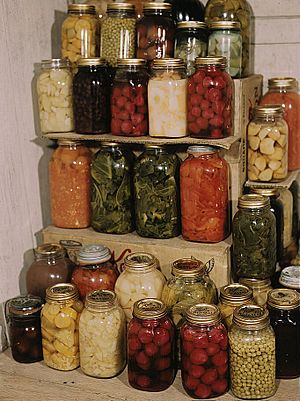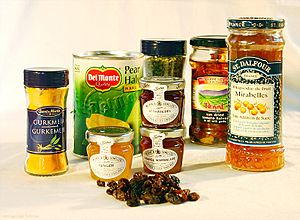Food preservation facts for kids
Food preservation is all about keeping food fresh and safe to eat for a longer time. It stops food from going bad, which is also called spoiling. For thousands of years, people have found clever ways to store food so they have enough to eat later. Simple methods like drying fish or meat in the sun have been used for ages. Even today, some groups of people still use these traditional ways to keep their food good.
Contents
Why Food Goes Bad
Food spoils because tiny living things called microorganisms (like bacteria or mold) start to grow on it. They change the food, making it unsafe or unpleasant to eat. To stop this, there are five main ways we can make food last longer:
- Killing or stopping growth: We can get rid of the microorganisms or stop them from multiplying.
- Blocking contact: We can prevent new microorganisms from getting onto the food.
- Removing needs: Microorganisms need certain things to live, like water or warmth. Taking these away can kill them.
- Concentrating ingredients: Making one part of the food very strong (like lots of sugar or salt) can stop microorganisms from using it.
- Adding helpers: Some special ingredients, called additives, can slow down or stop microorganisms from growing.
Often, food preservation uses a mix of these methods to work best.
Common Ways to Preserve Food
Here are some popular methods people use to preserve food:
Heating and Cooking
Heating food, like baking a hard biscuit, makes it last much longer than fresh ingredients. This is because the heat kills many of the microorganisms.
- Pasteurization: A scientist named Louis Pasteur discovered that gently heating liquids like milk kills most harmful microorganisms. This makes the milk safe and helps it stay fresh for longer.
Changing Food Form
Sometimes, changing food into a different form can make it last longer. For example, fresh goat's milk can be turned into cheese or yogurt, which stay good for much more time than the milk itself.
Using Salt and Vinegar
Salt and vinegar are great for stopping microorganisms.
- Pickling: This means putting vegetables, meat, or fish into a salty water mix called brine, or into vinegar. The salt or vinegar stops bad things from growing.
- Salting: Simply covering food with dry salt can pull out moisture and stop microorganisms from growing.
Adding Sugar or Alcohol
Large amounts of sugar or alcohol can also preserve food.
- Sugaring: Think of jam or fruit preserved in sugar syrup. The high sugar content makes it hard for microorganisms to grow.
- Alcohol: Putting food in a jar with alcohol (like Brandy) also helps preserve it.
Drying and Smoking
Removing water or adding smoke are old but effective methods.
- Drying: You can dry food in the sun or in an oven. Taking away the water makes it impossible for most microorganisms to survive.
- Smoking: This involves using smoke from burning wood to preserve food, often after it has been salted. The smoke adds flavor and helps stop spoilage.
Keeping Food Cold
- Refrigeration and Freezing: Keeping food cold in a refrigerator or freezer slows down or completely stops the growth of microorganisms. This is a very common way to preserve food today.
Using Special Chemicals
- Sulfur Dioxide: Sometimes, chemicals like sulfur dioxide are used. They help prevent food from spoiling by stopping certain chemical reactions.
Combining Methods
Many modern ways of preserving food use several of these ideas at once. For example:
- Pickles in a jar are often heated first, then put into a mix of vinegar and salty water.
- Fruit jams and jellies are heated and then mixed with a lot of sugar.
- Some preserved fruit is heated and then mixed with alcohol and a lot of sugar.
- Smoked hams are first treated with salty water (cured) and then smoked over burning wood.
Images for kids
-
A food scientist is preparing a meal for astronauts in space
-
Bag of Prague powder#1, also known as "curing salt" or "pink salt". It is typically a combination of salt and sodium nitrite, with the pink color added to distinguish it from ordinary salt.
-
3D stick model of nisin. Some lactic acid bacteria manufacture nisin. It is a particularly effective preservative.
See also
 In Spanish: Conservación de los alimentos para niños
In Spanish: Conservación de los alimentos para niños






